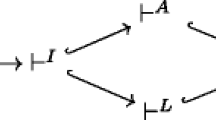Abstract
The purpose of a knowledge systemS is to represent the worldW faithfully. IfS turns out to be inconsistent containing contradictory data, its present state can be viewed as a result of information pollution with some wrong data. However, we may reasonably assume that most of the system content still reflects the world truthfully, and therefore it would be a great loss to allow a small contradiction to depreciate or even destroy a large amount of correct knowledge. So, despite the pollution,S must contain a meaningful subset, and so it is reasonable to assume (as adopted by many researchers) that the semantics of a logic system is determined by that of its maximally consistent subsets,mc-subsets. The information contained inS allows deriving certain conclusions regarding the truth of a formulaF inW. In this sense we say thatS contains a certain amount ofsemantic information and provides anevidence of F. A close relationship is revealed between the evidence, the quantity of semantic information of the system, and the set of models of its mc-subsets. Based on these notions, we introduce thesemantics of weighted mc-subsets as a way of reasoning in inconsistent systems. To show that this semantics indeed enables reconciling contradictions and deriving plausible beliefs about any statement including ambiguous ones, we apply it successfully to a series of justifying examples, such as chain proofs, rules with exceptions, and paradoxes.
Similar content being viewed by others
References
Aczel, J. and Daroczy, Z.,On Measures of Information and Their Characterizations. Academic Press, New York, 1975.
Baral, C., Kraus, S., Minker, J. and Subrahmanian, V. S., Combining knowledge bases consisting of first order theories,Lecture Notes in Artificial Intelligence, vol. 542, Z. Ras and M. Zemankova, eds., Springer-Verlag, New York, 1991, pp. 92–101.
Belnap, N. D., A useful four-valued logic,Modern Uses of Multiple-Valued Logic, G. Epstein and J. M Dunn, eds., D. Reidel, Dordrecht, 1977, pp. 5–37.
Blair, H. A. and Subrahmanian, V. S., Paraconsistent logic programming,Thoeretical Computer Science (1989), 135–154.
Brillouin, L.,Science and Information. Academic Press, New York, 1956.
Carnielli, W. A., Farinas del Cerro, L. and Lima Marques, M., Contextual negations and reasoning with contradictions,Proc. 12th IJCAI, Sydney, Australia, 1991, pp. 532–537.
Cook, S., The complexity of theorem-proving procedures,Proc. 3rd ACM Symp. on Theory of Computing, 1971, pp. 151–158.
da Costa, N. C. A., On the theory of inconsistent formal systems,Notre Dame J. Formal Logic 15 (1974) 497–510.
da Costa, N. C. A., Henschen, L. J., Lu, J. J. and Subrahmanian, V. S., Automatic theorem proving in paraconsistent logics: theory and implementation,10th International Conference on Automatic Deduction, Lecture Notes in AI, vol. 449, M. E. Stickel, ed., Springer-Verlag, New York 1990, pp. 72–86.
Fagin, R., Halpern, J. Y. and Vardi, M. Y., A nonstandard approach to the logical omniscience problem,Proc. 1990 Conf. on Theoretical Aspects of Reasoning about Knowledge (1990) 41–54.
Gallo, G. and Urbani, G., Algorithms for testing the satisfiability of propositional formulae,J. Logic Programming 7 (1989) 45–61.
Goldberg, A., Average case complexity of the satisfiability problem,Proc. 4th Workshop on Automated Deduction, Austin, Texas, 1979, pp. 1–6.
Goldberg, A., Purdom, P. and Brown, C., Average time analyses of simplified Davis-Putnam procedures,Information Processing Letters 15 (1982) 72–75.
Grant, J., Classifications for inconsistent theories,Notre Dame J. Formal Logic 19 (1978) 435–444.
Iwama, K., CNF satisfiability test by counting and polynomial average time,SIAM. J. Comput. 18 (1989) 385–391.
Kifer, M. and Lozinskii, E. L., RI: A logic for reasoning with inconsistency,Proc. 4th IEEE Symp. on Logic in Computer Science, Asilomar, California, 1989, pp. 253–262.
Kowalski, R. A. and Sadri, F., Logic programs with exceptions,Proc. 7th International Conf. on Logic Programming, D. H. D. Warren and P. Szeredi, eds., Jerusalem, 1990, pp. 598–613.
Linial, N. and Nisan, N., Approximate inclusion-exclusion.Combinatorica 10 (1990) 349–365.
Lozinskii, E., Answering atomic queries in indefinite deductive databases,Intl. J. Intelligent Systems 4 (1989) 403–430.
Lozinskii, E., Counting propositional models,Information Processing Letters 41 (1992) 327–332.
Lozinskii, E., Information and evidence in logic systems,J. Experimental and Theoretical Artificial Intelligence (to appear).
Luby, M. and Velickovic, B., On deterministic approximation of DNF,Proc. STOC'91, New Orleans, May 1991, pp. 430–438.
Pequeno, T. and Buchsbaum, A., The logic of epistemic inconsistency,Proc. 2nd International Conf. on Knowledge Representation and Reasoning, Cambridge, Mass., 1991, pp. 453–460.
Perlis, D., Truth and meaning,Artificial Intelligence 39 (1989) 245–250.
Priest, G., Reasoning about truth,Artificial Intelligence 39 (1989) 231–244.
Purdom, P. and Brown, C., The pure literal rule and polynomial average time,SIAM J. Comput. 14 (1985) 943–953.
Reiter, R., A logic for default reasoning,Artificial Intelligence 13 (1980) 81–132.
Rescher, N. and Brandom, R.,The Logic of Inconsistency, Oxford, 1980.
Slaney, J., The implications of paraconsistency,Proc. 12th IJCAI, Sydney, Australia, 1991, pp. 1052–1056.
Smullyan, R.,Forever Undecided, Oxford University Press, 1989.
Stein, L. A., Skeptical inheritance: Computing the intersection of credulous extensions,Proc. 11th IJCAI, 1989, pp. 1153–1158.
Touretzky, D. S., Horty, J. F. and Thomason, R. H., A clash of intuition: The current state of nonmonotonic multiple inheritance systems,Proc. 10th IJCAI, 1987, pp. 476–482.
Valiant, L. G., The complexity of computing the permanent.Theoretical Computer Science 8 (1979) 189–201.
Wagner, G., Ex contradictione nihil sequitur,Proc. 12th IJCAI, Sydney, Australia, 1991, pp. 538–542.
Author information
Authors and Affiliations
Rights and permissions
About this article
Cite this article
Lozinskii, E.L. Resolving contradictions: A plausible semantics for inconsistent systems. J Autom Reasoning 12, 1–31 (1994). https://doi.org/10.1007/BF00881841
Received:
Issue Date:
DOI: https://doi.org/10.1007/BF00881841




